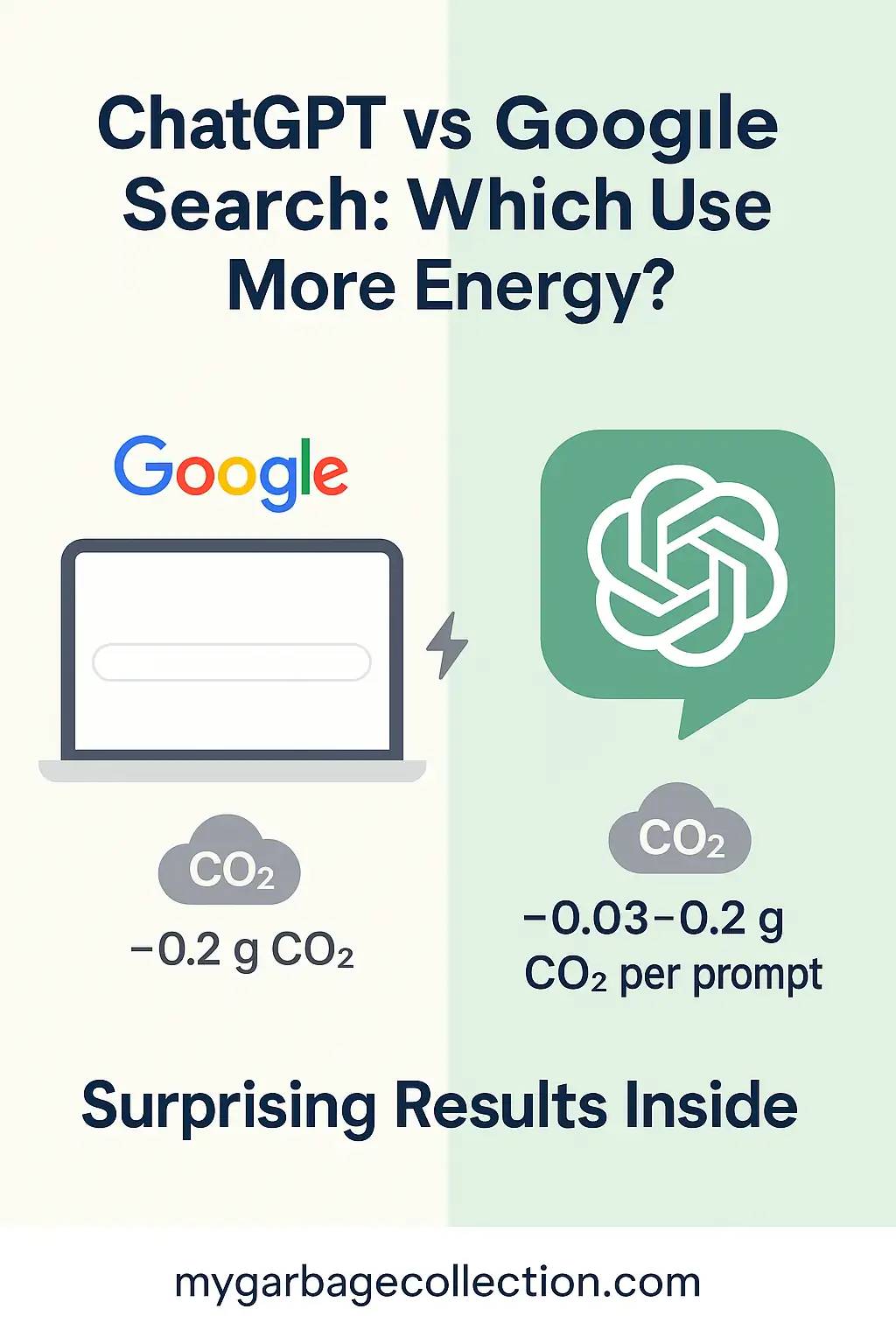Social Sustainability: The People Pillar of Sustainability
When we think of sustainability, many focus on environmental protection or profit. However, the true foundation lies in people. Social sustainability ensures that communities, employees, customers, and all stakeholders are treated fairly, included meaningfully, and supported for long term well being.
This pillar focuses on building a society that values human rights, inclusivity, and equity while promoting resilience and quality of life. Without strong social foundations, environmental and economic efforts cannot achieve lasting success.
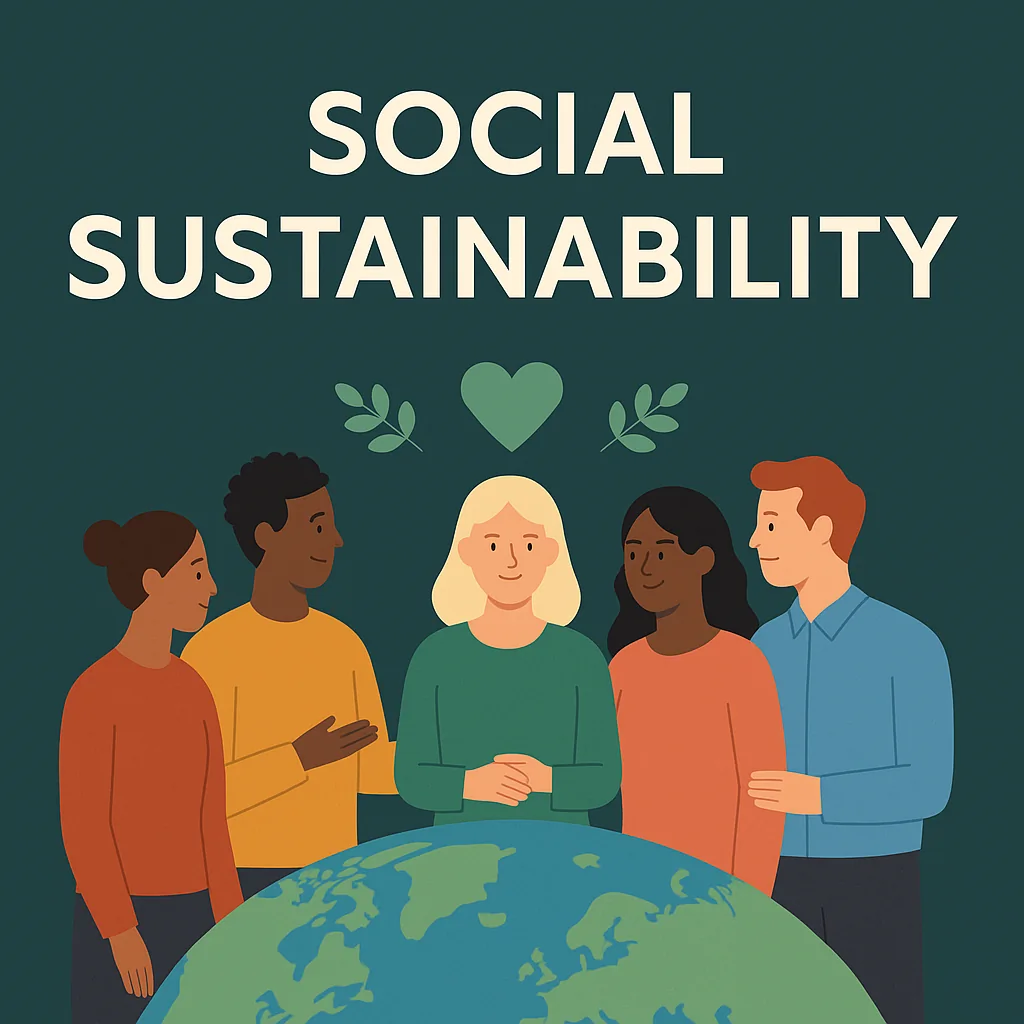
What is Social Sustainability?
Social sustainability is one of the three core pillars of sustainability — alongside environmental and economic sustainability — as explained in our full guide here.
It is about creating systems, structures, and relationships that support the health, well being, and dignity of people now and in the future.
It goes beyond charity work or corporate social responsibility. It is an integrated approach to governance, operations, and community engagement that ensures everyone has fair opportunities and is treated with respect.
According to global frameworks like ISO 26000 and the UN Guiding Principles on Business and Human Rights, social sustainability focuses on:
- Inclusion and diversity
- Fair labor practices
- Access to resources and opportunities
- Community development
- Stakeholder participation in decision making
The aim is to maintain a socially cohesive environment where all individuals can thrive without discrimination or marginalization.
Why Social Sustainability is Important
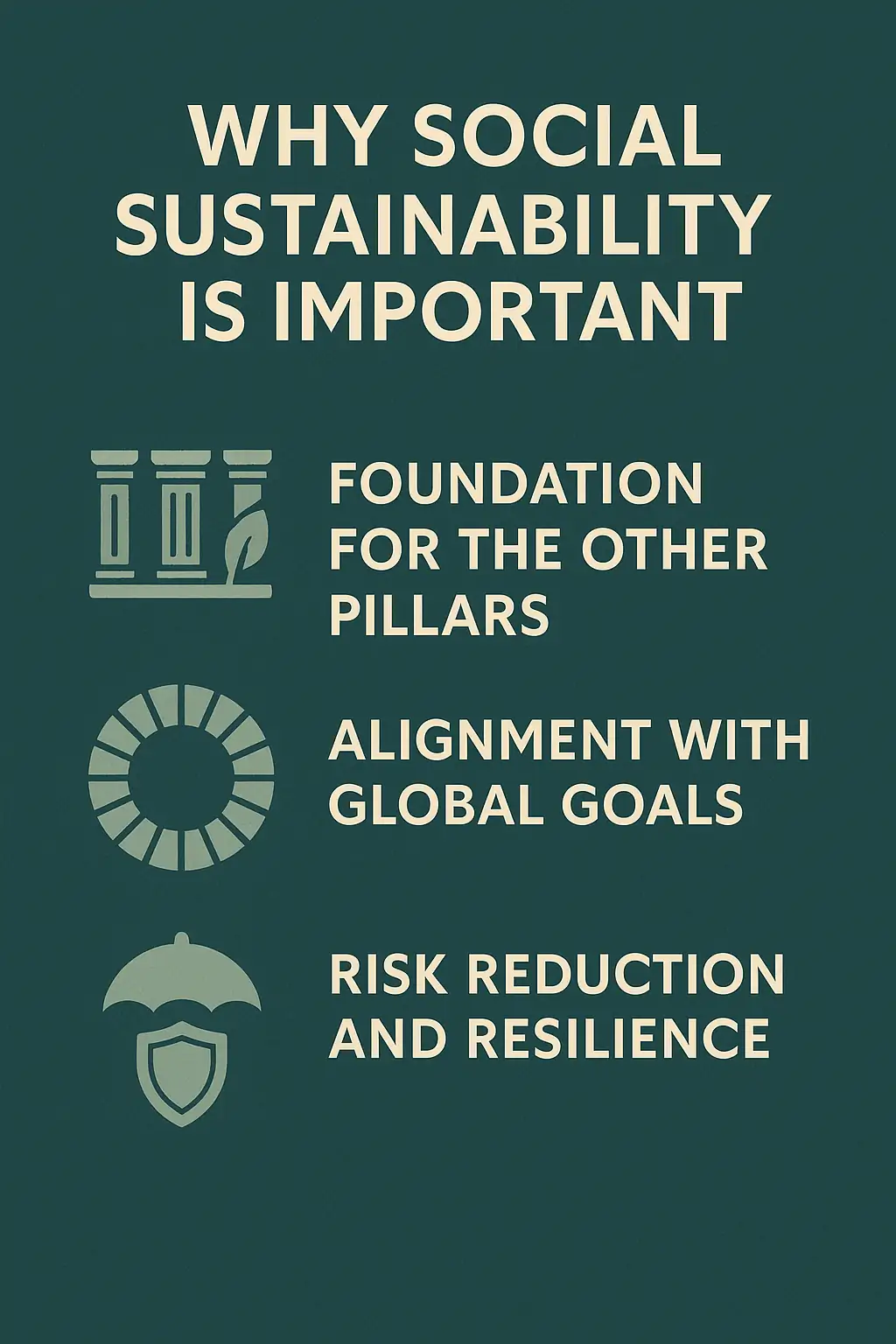
Foundation for the Other Pillars
The environmental and economic pillars of sustainability depend on stable and fair societies. Without a healthy social environment, ecological initiatives lack community support, and economic growth can lead to inequality.
Alignment with Global Goals
Social sustainability aligns closely with the United Nations Sustainable Development Goals (SDGs). Goals related to poverty reduction, gender equality, quality education, and decent work are all part of this pillar.
Risk Reduction and Resilience
Organizations that integrate social sustainability into their operations reduce risks such as labor disputes, reputational damage, and community resistance. Strong social systems create resilience during economic, environmental, or political challenges.
Key Dimensions of Social Sustainability
Equity and Inclusion
This dimension ensures that all people, regardless of background, gender, ethnicity, or economic status, have equal access to opportunities. Equity means removing barriers that prevent people from participating fully in society.
Safety and Well Being
A socially sustainable system protects physical and mental health. This includes workplace safety standards, access to healthcare, mental health support, and protection from violence or exploitation.
Social Cohesion and Resilience
Cohesion refers to the bonds that connect people within a community. Resilience is the ability of these communities to adapt and recover from challenges. Both require trust, collaboration, and shared values.
Process Legitimacy
Decisions should be made in ways that are transparent and inclusive. Stakeholder engagement, open communication, and fair representation ensure legitimacy.
Quality of Life
Social sustainability aims to improve living conditions through access to education, affordable housing, community facilities, and cultural participation.
Practical Strategies for Social Sustainability
Adopting Global Frameworks
Use recognized standards to guide social responsibility:
- ISO 26000 for guidance on social responsibility
- AA1000 Stakeholder Engagement Standard for effective participation
- UN Guiding Principles on Business and Human Rights for protecting rights across operations
These frameworks help create policies that address human rights, labor conditions, consumer protection, and community development.
Also Read: What Overindulgence Does to the Planet: Real Environmental Impacts Explained
Measuring Social Impact with KPIs
Tracking progress requires clear indicators. Examples include:
- Gender pay equity
- Workforce diversity percentages
- Employee training hours
- Workplace injury rates
- Employee turnover rates
- Community engagement sessions held
- Grievance resolution times
Broader indices like the Social Progress Index and Human Development Index can be used for benchmarking.
Integrating Social Criteria into Supply Chains
Social sustainability extends beyond direct operations. Supply chain policies should address:
- Fair wages for suppliers’ employees
- Safe working conditions
- Prevention of child and forced labor
- Supplier diversity programs
- Social audits and corrective action plans
Frameworks like ISO 20400 Sustainable Procurement help embed these requirements.
Community Engagement
Engaging with communities strengthens trust and cooperation. This can be done through:
- Public consultations and workshops
- Social impact assessments
- Partnerships with local organizations
- Support for local education and training programs
Transparent Reporting and Accountability
Publicly reporting on social initiatives builds credibility. Popular reporting frameworks include:
- GRI Standards (social topics such as labor practices, human rights, and community impacts)
- ESRS Social Standards (S1 to S4 covering workforce, value chain workers, communities, and consumers)
Real World Examples of Social Sustainability
Fashion Industry Reform
In the fashion industry, multi stakeholder initiatives are working to ensure that workers in manufacturing countries have a voice in decision making. This ensures that changes in sustainability benefit all levels of the supply chain.
Technology and Digital Inclusion
Tech companies are addressing social sustainability by ensuring digital access for underserved communities, protecting user privacy, and promoting ethical AI use.
Construction and Worker Welfare
Construction firms are improving worker housing, safety standards, and fair recruitment processes to protect migrant workers.
Social Sustainability in Different Contexts
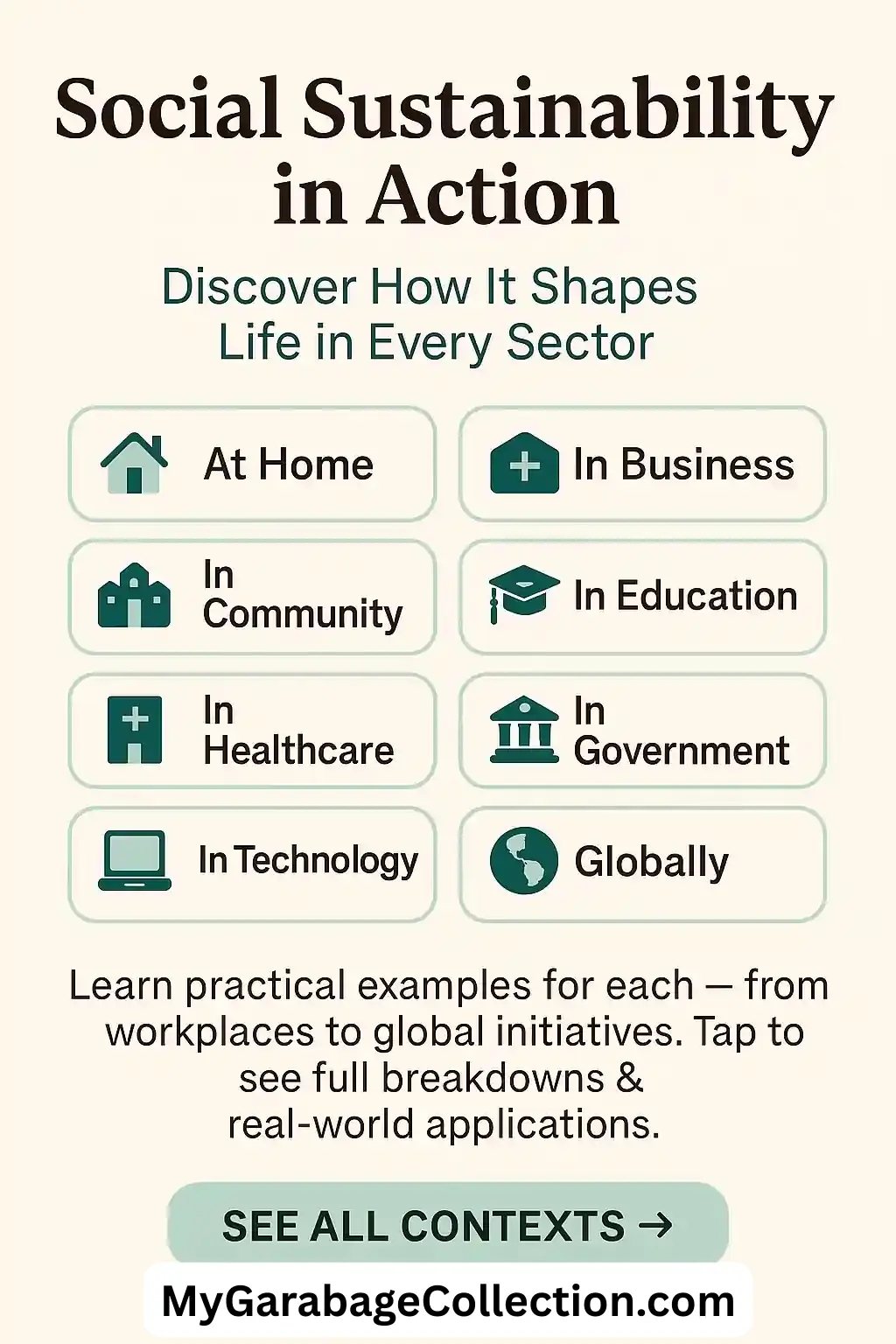
Building a Social Sustainability Strategy
A strong social sustainability strategy ensures that equity, inclusion, and well being are embedded into every part of your organization.
Assess Current Performance
Review existing practices using KPIs like diversity ratios, training hours, workplace safety rates, and employee turnover. Collect feedback from employees, suppliers, and communities to identify strengths and gaps.
Identify Material Social Issues
Prioritize the issues with the biggest impact, such as fair wages, safe working conditions, diversity, or community support. Engage stakeholders to validate these priorities.
Set Measurable Goals
Create SMART goals aligned with global frameworks like the SDGs. Examples include increasing workforce diversity, ensuring supplier compliance, or reducing injury rates.
Implement Policies Across Operations and Supply Chains
Integrate social requirements into recruitment, training, and supplier agreements. Adopt sustainable procurement practices and maintain a clear supplier code of conduct.
Review and Improve
Track progress through regular monitoring, audits, and public sustainability reports. Update policies as needs change and celebrate achievements to build trust.
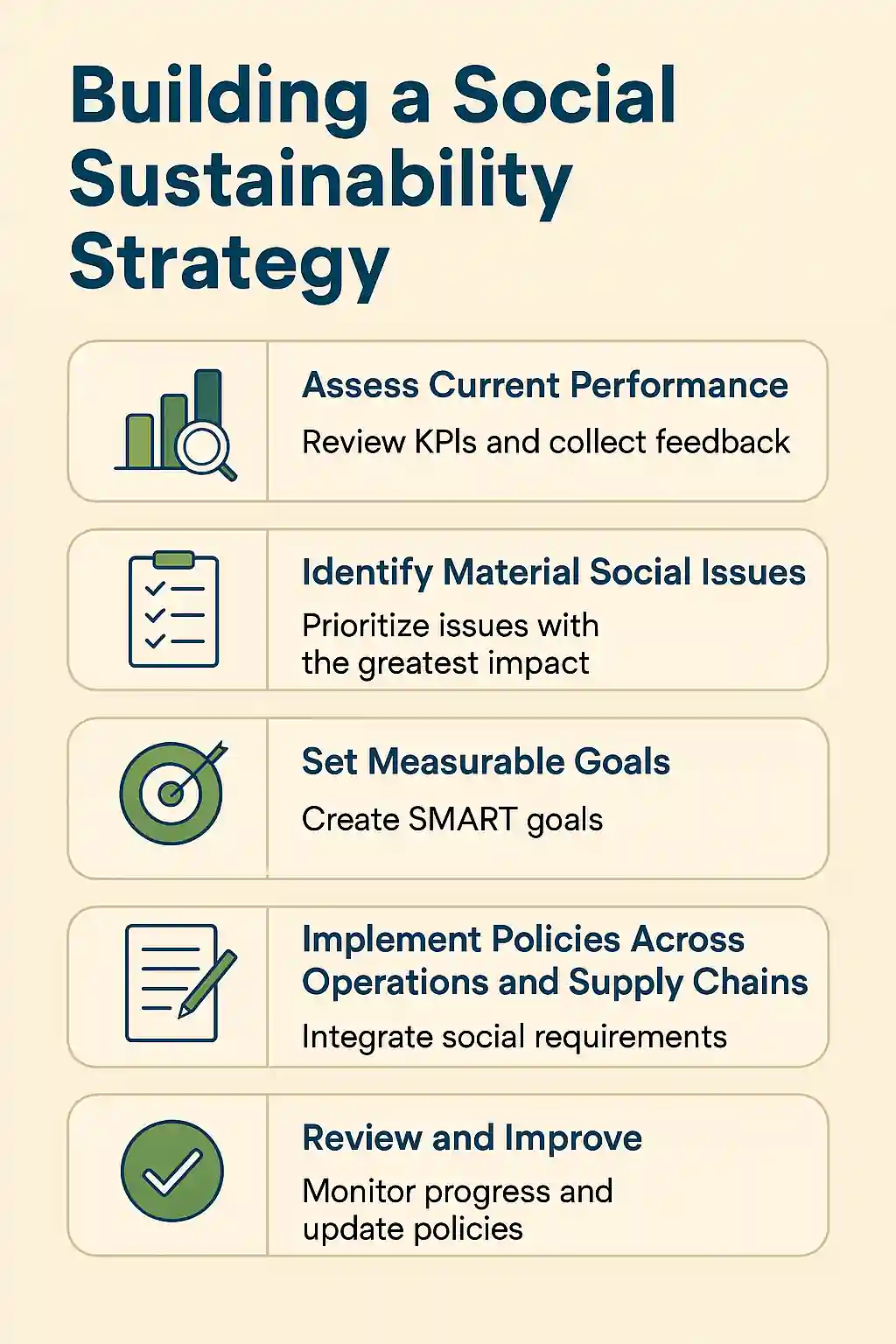
Careers and Jobs in Social Sustainability
Social sustainability jobs focus on creating equitable, inclusive, and supportive environments within organizations and communities. These roles are found across industries, from corporate offices and non profits to government agencies and international development organizations.
Professionals in this field work on initiatives such as diversity and inclusion programs, employee well being, community development, human rights advocacy, and ethical supply chain management. Common job titles include Sustainability Manager, Corporate Social Responsibility (CSR) Specialist, Diversity and Inclusion Officer, Community Engagement Coordinator, Human Rights Analyst, and Ethical Procurement Officer.

Skills required for these roles often include stakeholder engagement, policy development, data analysis for social impact metrics, and a deep understanding of frameworks like the UN Sustainable Development Goals (SDGs), ISO 26000, and GRI Standards.
As companies increasingly recognize the importance of the social pillar in sustainability, demand for professionals who can integrate people centered strategies into business operations continues to grow, making this a promising and impactful career path.
Frequently Asked Questions About Social Sustainability
It is the practice of creating fair, inclusive, and supportive work environments while positively impacting communities and protecting human rights.
Through metrics like diversity ratios, safety statistics, employee engagement scores, grievance resolution rates, and living wage coverage.
CSR often refers to voluntary initiatives, while social sustainability is integrated into the core operations and strategy of a business.
ISO 26000, UN Guiding Principles on Business and Human Rights, AA1000 Stakeholder Engagement Standard, GRI Social Standards, and ESRS Social Standards.
Conclusion
Social sustainability is the human side of the sustainability equation. By ensuring fairness, equity, inclusion, and quality of life, it strengthens communities and organizations alike.
When businesses and governments commit to social sustainability, they create a foundation for environmental protection and economic growth to thrive. This is the pillar that connects our shared values to a future where both people and the planet can prosper.
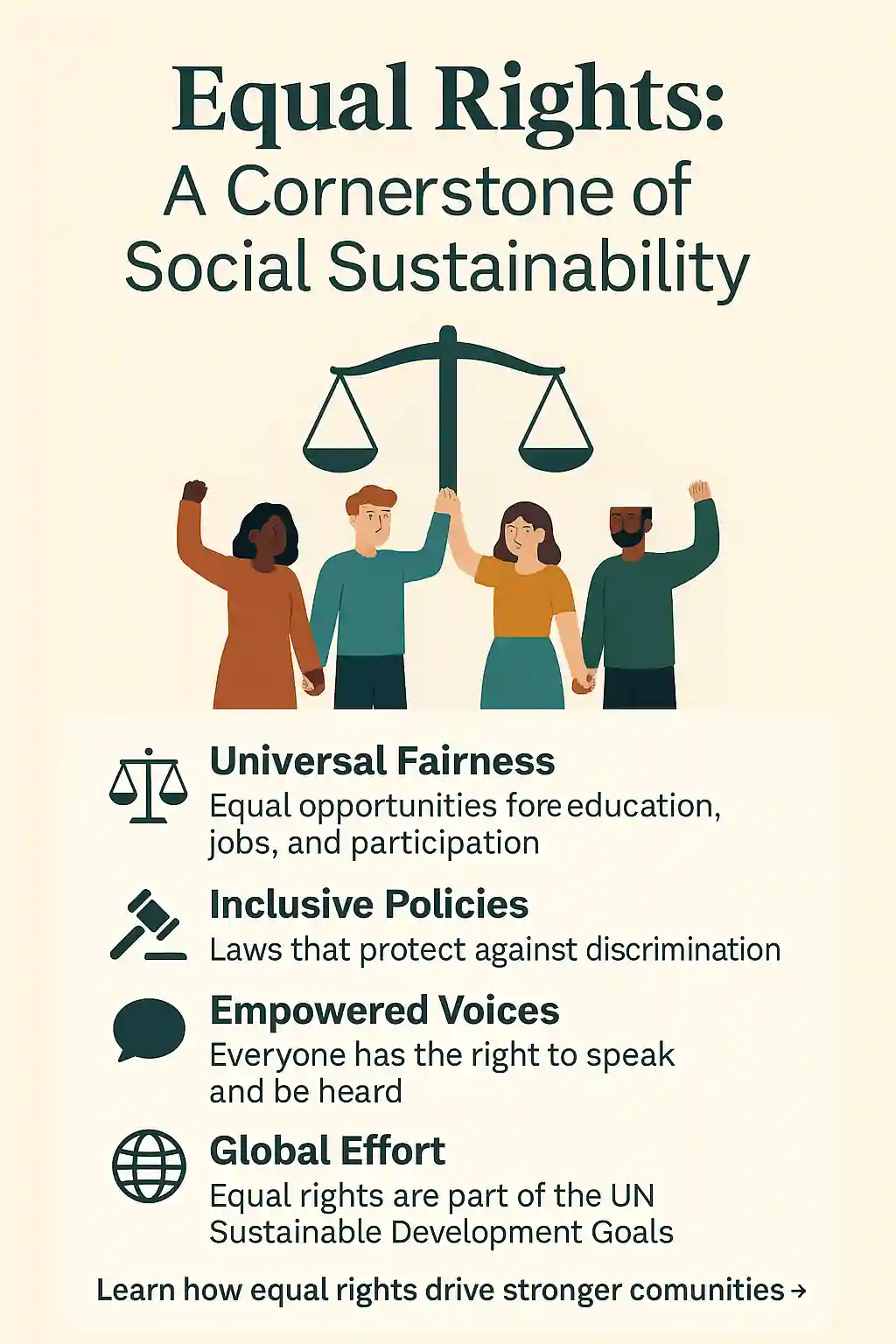
Also Read:






